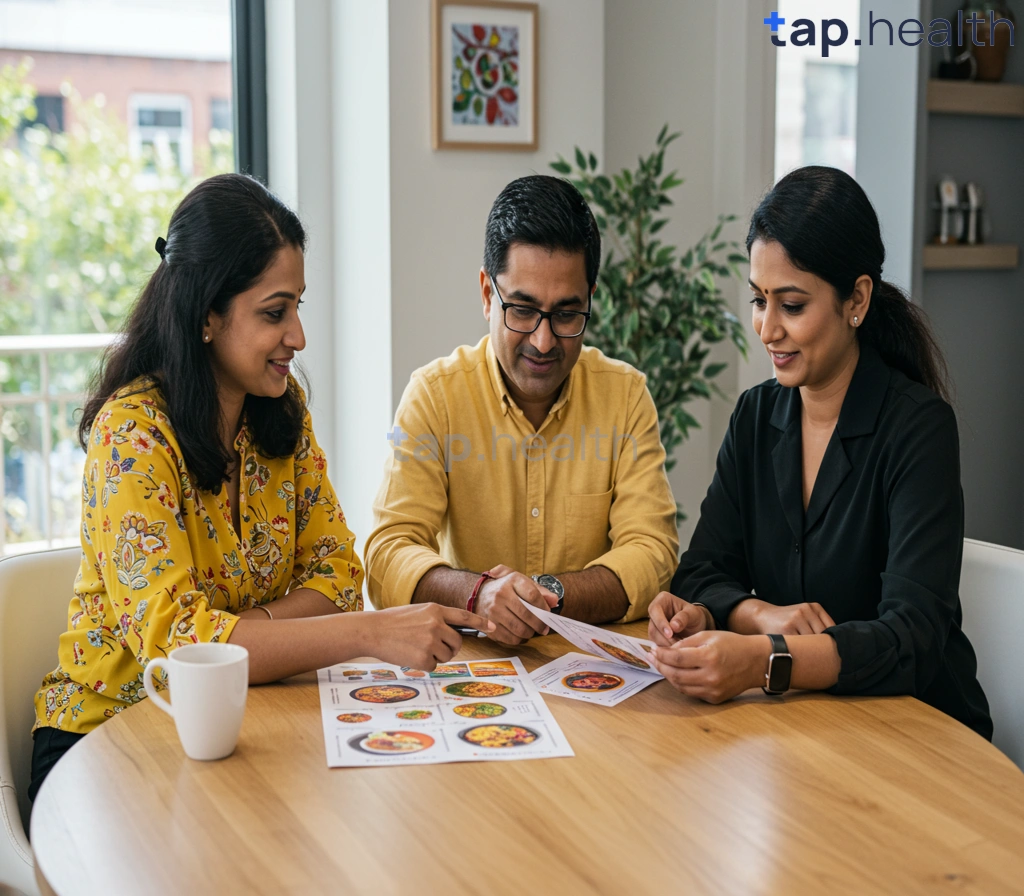Table of Contents
- Master Diabetes Meal Planning: Your Guide to Blood Sugar Control
- Diabetes-Friendly Recipes: Delicious Meals to Manage Blood Sugar
- Effective Diabetes Meal Planning Strategies for Weight Management
- Prevent Blood Sugar Spikes: A Simple Diabetes Meal Plan
- Is Your Current Meal Plan Working? Evaluate Your Diabetes Diet
- Frequently Asked Questions
- References
Living with diabetes doesn’t mean sacrificing delicious food! In fact, with the right knowledge and planning, you can enjoy a diverse and satisfying diet while effectively managing your blood sugar. This blog is all about Diabetes Meal Planning: Prevent and Manage Blood Sugar Effectively. We’ll explore practical strategies, delicious recipes, and helpful tips to simplify the process of creating meal plans that support your health goals. Say goodbye to confusing dietary restrictions and hello to empowered eating – let’s embark on this journey together to discover how simple changes can make a big difference in your diabetes management.
Master Diabetes Meal Planning: Your Guide to Blood Sugar Control
Maintaining healthy blood sugar levels is crucial for managing diabetes, especially in hot and humid climates common in Indian and tropical countries. Remember, pre-meal blood sugar should ideally be between 80–130 mg/dL, and post-meal levels should remain below 180 mg/dL. Failing to achieve these targets can lead to serious complications. This means careful meal planning is essential.
Prioritizing Whole Grains and Seasonal Produce
Indian and tropical regions boast an abundance of fresh, seasonal fruits and vegetables. Incorporate these into your diet liberally. Choose whole grains like brown rice, millets (like ragi or bajra), and oats over refined carbohydrates. These foods are digested more slowly, preventing rapid spikes in blood sugar. Consider incorporating traditional Indian dishes, but modify them to reduce unhealthy fats and added sugars. For example, use less oil in curries and opt for healthier cooking methods like steaming or grilling.
Portion Control and Balanced Meals
Maintaining appropriate portion sizes is vital. Each meal should include a balance of carbohydrates, proteins, and healthy fats. Lean proteins like lentils (dal), fish, and chicken are excellent choices. Healthy fats from sources like nuts, seeds, and avocados contribute to satiety and help regulate blood sugar. Remember to spread your carbohydrate intake throughout the day, rather than consuming large amounts in a single sitting.
Hydration and Regional Considerations
Staying well-hydrated is critical, especially in warmer climates. Dehydration can affect blood sugar levels. Drink plenty of water throughout the day. Consider incorporating hydrating beverages like coconut water, which is readily available in many tropical regions. Also, be mindful of high-sugar drinks and limit their consumption. Consult a doctor or registered dietitian for personalized advice tailored to your specific needs and dietary preferences within your region. For more tips on managing your diabetes effectively, check out 10 Proven Tips for Effective Diabetes Management. As you age, managing diabetes can present unique challenges. Learn more about this in our comprehensive guide: Managing Diabetes as You Age: Challenges and Solutions.
Diabetes-Friendly Recipes: Delicious Meals to Manage Blood Sugar
Managing Carbohydrates for Balanced Blood Sugar
Effective diabetes management hinges on mindful eating, particularly controlling carbohydrate intake. For most individuals, aiming for around 45–60 grams of carbohydrates per meal is a good starting point, though this can vary depending on individual needs, activity levels, and medications. Remember to consult your doctor or a registered dietitian to determine the ideal carbohydrate range for you. This personalized approach is crucial for maintaining stable blood sugar levels.
Delicious and Accessible Recipes for Indian and Tropical Climates
Many delicious and easily accessible ingredients in Indian and tropical countries are naturally low in carbohydrates or can be incorporated into meals to balance carbohydrate portions. Think of incorporating plenty of leafy greens, non-starchy vegetables like broccoli and cauliflower, and lean protein sources such as fish, lentils, and chicken. Spices, readily available throughout these regions, add flavour without impacting blood sugar significantly. Explore dishes featuring coconut milk (in moderation), which can add richness and creaminess to curries and stews. For more ideas on the best foods to include in your diet, check out 20 Best Foods for People with Diabetes – Tap Health.
Practical Tips for Meal Planning
Prioritize whole grains over refined carbohydrates. Opt for brown rice or quinoa instead of white rice, and choose whole-wheat roti over refined flour versions. Portion control is also key; even healthy carbohydrates contribute to overall calorie intake. Plan your meals ahead to ensure you consistently meet your dietary goals. Consider using smaller plates to visually manage portion sizes. By focusing on balanced meals rich in fiber and nutrients, you can enjoy delicious and satisfying food while effectively managing your blood sugar. Planning ahead is especially important for special occasions; learn how to adapt your recipes for celebrations by reading Creating Diabetes-Friendly Dishes for the Holidays.
Take Control of Your Health Today
Start exploring diabetes-friendly recipes that incorporate the readily available ingredients in your region. Remember, consistent effort and a personalized approach are key to successful diabetes management. Consult your healthcare provider for tailored advice and support.
Effective Diabetes Meal Planning Strategies for Weight Management
Managing diabetes, particularly in tropical and Indian climates, requires a nuanced approach to meal planning. The challenge is amplified considering that a significant portion of the diabetic population falls within the 20-64 age group (61%), a demographic often juggling busy lifestyles. Effective weight management is crucial for better diabetes control, and smart meal planning is the cornerstone.
Prioritizing Fresh, Local Produce
Indian and tropical regions boast an abundance of fresh fruits and vegetables packed with fiber and nutrients. Incorporating these into your daily meals is key. Think leafy greens like spinach and fenugreek, vibrant vegetables like okra and bitter gourd, and seasonal fruits rich in antioxidants. These foods help regulate blood sugar levels and contribute to a healthy, balanced diet. Prioritize whole grains like brown rice and millets over refined carbohydrates for sustained energy release.
Managing Portion Sizes and Meal Timing
Portion control is vital for weight management. Smaller, more frequent meals can prevent blood sugar spikes. Additionally, the timing of your meals is critical. Avoid large meals close to bedtime. Consider consulting a dietitian to develop a personalized meal plan that caters to your specific needs and preferences. Remember to stay hydrated, particularly in hotter climates, as dehydration can impact blood sugar levels. For more specific guidance on portion sizes and meal timing, you might find Diet Chart for Diabetic Patients to Control Diabetes helpful.
Spices and Flavorful Cooking
Indian cuisine, particularly, offers a wealth of spices with potential health benefits. Turmeric, cinnamon, and ginger, for instance, are known for their anti-inflammatory and blood sugar-regulating properties. Experiment with these spices to add flavor to your meals without relying on excessive sugar or unhealthy fats. This is crucial for maintaining a healthy weight while enjoying delicious, culturally relevant food. Embrace the diverse culinary landscape of your region to create sustainable, enjoyable meal plans. If you’re looking for a comprehensive approach to weight loss within a diabetic diet, check out How to Lose Weight with Diabetes Diet Plan.
Prevent Blood Sugar Spikes: A Simple Diabetes Meal Plan
Maintaining healthy blood sugar levels is crucial, especially in regions like India and other tropical countries where dietary habits can significantly impact diabetes risk. Remember, blood sugar levels less than 140 mg/dL are considered normal, while levels between 140–199 mg/dL indicate prediabetes, and 200 mg/dL or higher suggests diabetes. A well-planned diet is your first line of defense.
Prioritize Complex Carbohydrates
Instead of refined carbohydrates like white rice and sugary snacks common in many Indian and tropical diets, opt for complex carbohydrates. These digest more slowly, preventing rapid blood sugar spikes. Think brown rice, whole wheat roti, millets (like ragi and jowar – incredibly popular in India), and oats. Incorporating these into your meals provides sustained energy and helps manage blood sugar effectively.
Embrace Fiber-Rich Foods
Fiber plays a vital role in regulating blood sugar. Fruits like mangoes and bananas (popular in tropical climates), along with vegetables like spinach and lentils (staples in Indian cuisine), are excellent sources. These foods slow down glucose absorption, keeping blood sugar levels stable. Aim for a diet rich in these foods to prevent those dangerous spikes. For more tips on managing blood sugar after meals, check out our article on How to Prevent Blood Sugar Spikes After Meals.
Control Portion Sizes
Even healthy foods can lead to high blood sugar if consumed in excessive amounts. Practicing mindful eating and controlling portion sizes is essential. This is particularly important in cultures where generous servings are common. Pay attention to your body’s hunger cues and avoid overeating.
Choose Lean Protein and Healthy Fats
Include lean protein sources like fish, chicken, beans, and lentils in your meals. These help you feel full and satisfied, preventing overconsumption of carbohydrates. Healthy fats from sources like nuts, seeds, and avocados also contribute to better blood sugar control. Remember to consult a doctor or registered dietitian for personalized dietary advice tailored to your specific needs and local food availability. Learning how to prevent those post-meal spikes can make a big difference, so we recommend reading our guide on How to Prevent Blood Sugar Spikes.
Is Your Current Meal Plan Working? Evaluate Your Diabetes Diet
Managing diabetes effectively in India and tropical countries requires a mindful approach to nutrition. Are you seeing the results you want? Over 30% of diabetes patients in the region report HbA1c levels above 9%, highlighting the urgent need for improved dietary strategies. This statistic underscores the importance of regularly evaluating your diabetes meal plan. Simply put, your current diet might not be working as well as you think.
Understanding Your Blood Sugar Levels
Regular blood glucose monitoring is crucial. Are your levels consistently within your target range? Pay attention to how different foods affect your blood sugar. Do you experience significant spikes after certain meals? Tracking your food intake and corresponding blood sugar levels will help pinpoint problem areas in your diet. Consider keeping a food diary, noting portion sizes and meal timing. This allows you to identify any patterns and make necessary adjustments.
Adapting Your Meal Plan for Tropical Climates and Indian Cuisine
Indian cuisine, while delicious and diverse, can sometimes pose challenges for diabetes management. Focus on incorporating more fiber-rich foods like lentils, vegetables, and whole grains. Choose lean proteins and limit refined carbohydrates like white rice and sugary desserts. The abundance of fresh fruits and vegetables available in tropical regions provides a wealth of naturally sweet and nutritious options. Remember portion control is key. For more information on different dietary approaches, you might find our article on Low-Carb vs. Moderate-Carb Diets for Diabetes: What Works Best? helpful.
Seeking Professional Guidance
If you’re struggling to manage your blood sugar effectively despite your best efforts, seeking professional help is vital. Consult a registered dietitian or certified diabetes educator. They can provide personalized guidance tailored to your specific needs, dietary preferences, and cultural background within the Indian and tropical context. Taking proactive steps towards better diabetes management will significantly improve your overall health and well-being. If you’re pre-diabetic and looking for ways to prevent the onset of diabetes, check out our guide on Pre Diabetic Diet Chart: Simple Plans to Prevent Diabetes.
Frequently Asked Questions
Q1. What is the key to effective diabetes management in tropical climates, particularly in India?
Prioritizing balanced meals is key. Focus on whole grains (brown rice, millets), seasonal fruits and vegetables, and lean proteins (lentils, fish, chicken). Control portion sizes, limit refined carbs and added sugars, and aim for 45-60 grams of carbohydrates per meal (adjust as needed). Stay well-hydrated.
Q2. How can I adapt my traditional Indian diet to better manage my blood sugar?
Many traditional Indian spices can enhance flavor without significantly affecting blood sugar. Focus on modifying existing dishes by substituting refined carbs with whole grains and incorporating more vegetables and lean proteins. Mindful eating and portion control are crucial.
Q3. What role does regular monitoring and professional guidance play in diabetes management?
Regular blood glucose monitoring is essential to track your progress and make necessary adjustments. Consulting a doctor or registered dietitian is vital for personalized advice, ensuring your meal plan meets your specific needs and helps with weight control.
Q4. What are the ideal carbohydrate amounts for a meal, and how do I adjust them?
Aim for 45-60 grams of carbohydrates per meal. However, this is a general guideline. Your individual needs may vary based on factors like age, activity level, and overall health. A doctor or dietitian can help determine the optimal carbohydrate intake for you.
Q5. Are there any common misconceptions about diabetes management in hot climates that I should be aware of?
A common misconception is that dietary restrictions are overly harsh. You can still enjoy many traditional foods by making smart substitutions and focusing on portion control. It’s about making balanced choices rather than eliminating entire food groups.
References
- A Practical Guide to Integrated Type 2 Diabetes Care: https://www.hse.ie/eng/services/list/2/primarycare/east-coast-diabetes-service/management-of-type-2-diabetes/diabetes-and-pregnancy/icgp-guide-to-integrated-type-2.pdf
- Diabetes Mellitus: Understanding the Disease, Its Diagnosis, and Management Strategies in Present Scenario: https://www.ajol.info/index.php/ajbr/article/view/283152/266731





